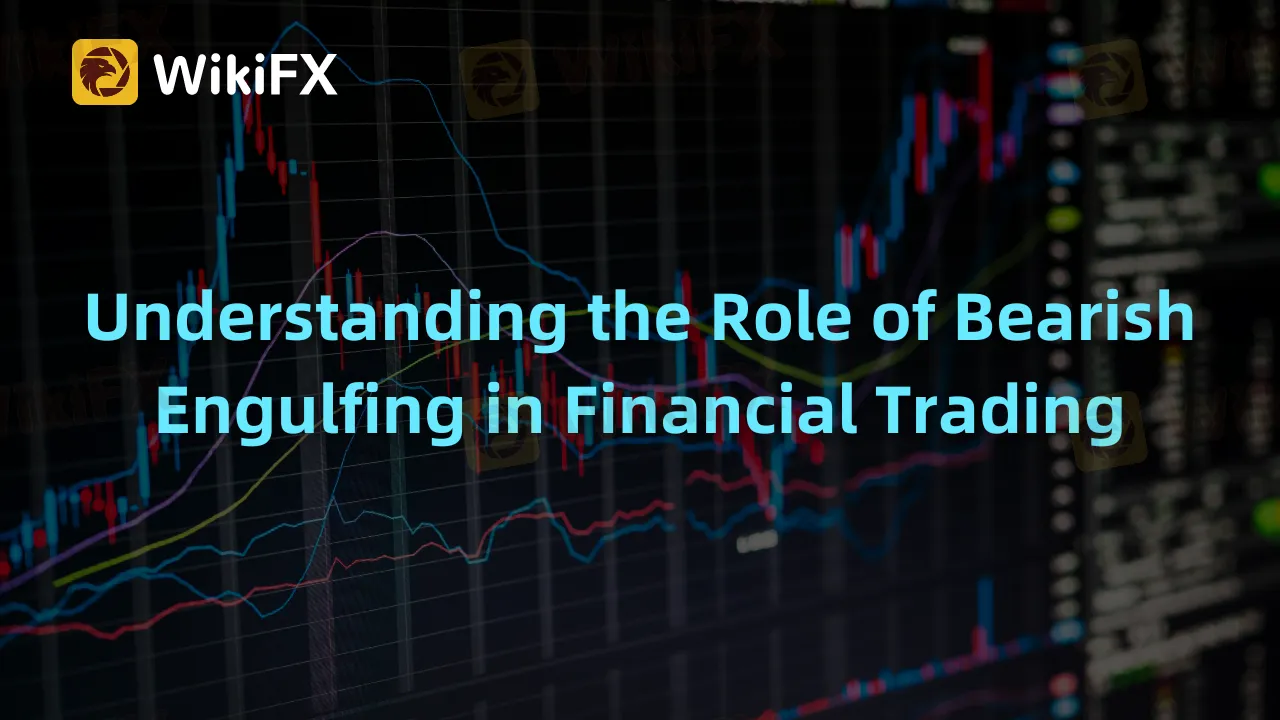简体中文
繁體中文
English
Pусский
日本語
ภาษาไทย
Tiếng Việt
Bahasa Indonesia
Español
हिन्दी
Filippiiniläinen
Français
Deutsch
Português
Türkçe
한국어
العربية
Understanding the Role of Bearish Engulfing in Financial Trading
Abstract:The study analyzed about 37,000 forex candles, identifying over 200 Bearish Engulfings (BEs), suggesting BEs serve better as market peaking signals rather than reversal ones. While the average post-BE trend showed a slight downward bias, about 2/3 stayed below the peak, indicating potential predictive power.

The Bearish Engulfing (BE) is a prominent candlestick formation that can be detected across multiple financial trading instruments. It needs nothing more than an opening, high, low, and closing price for identification. As suggested by the name, technical traders commonly use this as an indicator that a rising market may be on the cusp of a reversal. However, one must remember that previous performance doesn't necessarily predict future outcomes.
The objective of this educational article is not to delve into the nuances of Bearish Engulfing, but to evaluate their effectiveness using only price information. This data will be drawn from the foreign exchange market (forex). At the end of this discussion, we will recap the key insights and mention some of the limitations of this research. Let's lay some ground rules first.
Spotting Bearish Engulfing – A Case Study of EUR/USD, GBP/USD, USD/JPY, AUD/USD, USD/CAD
Around 37,000 candles across EUR/USD, GBP/USD, USD/JPY, AUD/USD, and USD/CAD were analyzed using daily data from TradingView since 1995. One of the reasons why the forex market was selected is due to its unmatched liquidity, particularly among the major pairs, which results in more streamlined price action compared to markets like stocks and cryptocurrencies.
The identification of Bearish Engulfing was based on a pre-set of rules I coded, scanning each candle to verify its validity. For this study, I focused on a short-term horizon, meaning 20 days before and after an engulfing.
Let's take a look at some of the most critical rules used in Bearish Engulfing detection:
Bearish Engulfing Detection Criteria:
1. The Bearish Engulfing body must meet a minimum size requirement, it can't be excessively small.
2. The body of the preceding candle (the pre-candle) can't be too small in comparison to the BE body.
3. The BE must close below the pre-candle open, rather than the pre-candle low.
4. Before the BE, there must be signs of an uptrend (no flat price action or downtrends).
5. The pre-candle close must also be a 20-day high close, allowing for a slight margin of error.
Limitations and subjectivity related to these rules will be addressed later. For now, let's review an example of a detected EUR/USD Bearish Engulfing from March 13th, 2005. It shows a clear uptrend before the BE and a 20-day high close of the pre-candle. After the BE, the price declined as expected.
The code identified slightly more than 200 Bearish Engulfings out of nearly 37,000 candles. Naturally, not all of them were as clear-cut as the one demonstrated.

37,000 Candles, Over 200 Bearish Engulfings - What Do the Trends Say?
The chart below presents each Bearish Engulfing trend 20 days before and after its occurrence. To ensure consistent scaling, each BE (close) was indexed to 100 as a reference point.
In the phase leading up to the BE, it's visible that the trends rose steadily and predictably. However, the day preceding the BE always peaked. This leads to the dip into the BE, marking the close below the pre-candle.
Post-Bearish Engulfing Trajectories
Post the Bearish Engulfing, trends persist for 20 days, widening into a conical or triangular shape as time passes. The right side of the graph shows greater price dispersion (variance) than the left, characterized by numerous peaks and troughs. At first sight, this might suggest randomness, casting doubt on the reliability of Bearish Engulfings as regular reversal signals. However, a closer examination is required.

Inspecting the Typical Bearish Engulfing Trend
The next chart helps in understanding the average Bearish Engulfing trend. It confirms that the code reliably captured the uptrend preceding the BE. As with the earlier chart, you can see the peak just before the BE, followed by a dip to 100, symbolizing the descent into the engulfing. Post engulfing, prices continued to fall, finishing at an average of -0.28% 20 days after the BE. While this indicates a mild downward bias in the post-BE trend, it's not the crucial takeaway from this analysis.

Bearish Engulfings: Are They Reversal or Peaking Signals?
The final chart overlays the average Bearish Engulfing series with the percentage of trends that closed below the pre-candle for each day. For instance: after 5 days, 71% of trends stayed below the pre-candle close. After 10 days, this figure reduced to 66%, then rose to 68% on the 15th day and finally ended at 65% on the 20th day. In other words, on average, about two-thirds (2/3) of trends remained below the peak after one month.
An interesting observation is that the ending price observations after 20 days formed a statistically significant normal distribution. This means we can use a Cumulative Distribution Function (CDF) to calculate the probability of a series in this sample finishing below the peak. Consistent with the results mentioned earlier, this is approximately 65%.

What's the Final Say on Bearish Engulfings?
After analyzing nearly 37,000 candles between EUR/USD, GBP/USD, USD/JPY, AUD/USD, and USD/CAD, and identifying over 200 Bearish Engulfings, it appears that this candlestick pattern serves better as a peaking signal than a reversal one. While the average trend finished almost -0.3% after 20 days, 2/3 of them stayed below the peak. This implies that if we can spot valid Bearish Engulfings in this market, it might be worth monitoring. Now, let's discuss some limitations of this study.
Limitations of the Study
While Bearish Engulfings can be found universally across markets, understand that this study focused on a specific subset of the forex market. Hence, the results may be most relevant to the pairs studied. Also, this research is based on a sample of just over 200 Bearish Engulfings. A larger sample might be needed to bolster the validity of this study (or perhaps contradict it).
Despite efforts to maintain objectivity, technical analysis inherently involves a degree of subjectivity. While there's broad agreement on the characteristics of a Bearish Engulfing, the context in which they form is more variable. In this sample, I considered if the BE closed below the pre-candle open rather than the pre-candle low, which may be debated by some.
The timeframe is another crucial aspect. This study was conducted on daily data, but other time horizons could theoretically be analyzed. This includes the duration you measure before and after the engulfing. This study focused on short-term price action, but broader trends could also be analyzed, such as 40 days before and after the Bearish Engulfing.
Conclusion
The study provides insights into the nature of Bearish Engulfing patterns within the forex market and their potential predictive power. Our findings suggest that while the average trend after a BE may show a slight downward bias, the primary value of BE patterns might lie in their capacity to signal market peaks rather than trend reversals. This makes them a potentially valuable tool for traders in interpreting market conditions and managing risk.
However, this study also highlights the limitations and potential areas of subjective interpretation inherent in technical analysis. It emphasizes the need for a comprehensive and diversified approach to market analysis, incorporating multiple timeframes, indicators, and types of data. Ultimately, successful trading strategies must adapt to the ever-changing dynamics of the forex market, and no single pattern or indicator can provide a foolproof guide to future price movements. Therefore, traders should use BE patterns as part of a broader, balanced analytical toolkit.
Dive into the world of breaking news! Just grab your smartphone, download and set up the WikiFX App, and you'll never miss a beat. Don't miss out on being in the know - click here to download the app: https://social1.onelink.me/QgET/px2b7i8n. With a simple touch, the latest updates are all yours!

Disclaimer:
The views in this article only represent the author's personal views, and do not constitute investment advice on this platform. This platform does not guarantee the accuracy, completeness and timeliness of the information in the article, and will not be liable for any loss caused by the use of or reliance on the information in the article.
Related broker
Read more

WikiFX "3·15 Forex Rights Protection Day" – Official Release of the Blacklist
WikiFX, as a globally leading forex investment ecosystem service platform, has always been committed to providing fair and authoritative broker verification services for forex investors, while offering solid rights protection support for every victim of forex investment. On February 26, 2025, WikiFX once again launched its annual "3·15 Forex Rights Protection Day" event, aiming to empower forex investors to speak out and defend their rights through open, transparent, and robust means.

Nigeria’s Oil and Gas Sector Gains Momentum
Nigeria’s oil and gas industry is experiencing a surge in investment, fueled by policy reforms and international collaboration, paving the way for continued energy expansion.

The Global Tariff War Escalates: Who Suffers the Most?
The global trade war is intensifying as countries continue to raise tariffs, aiming to protect their own economies while creating greater market uncertainty. In this tit-for-tat game, who is truly bearing the brunt?

Immediate Edge Review 2025: Is it safe?
Launched in 2019, Immediate Edge claims to be an automated cryptocurrency trading platform using AI technology for crypto trading services. The platform requires a minimum deposit of $250 to begin trading, which is relatively expensive for many investors. During its short operation, Immediate Edge failed to establish a positive reputation. The platform has undergone frequent domain changes and has repositioned itself as an intermediary connecting users with investment firms—a move that appears designed to obscure its actual operations. Immediate Edge restricts services to investors from the United States; it remains accessible to users in other regions.
WikiFX Broker
Latest News
Trump vs. Powell: The Showdown That Will Shape Global Markets
FINRA Panel Orders Stifel to Pay $132.5M for Misleading Investors
The Future of Trading is Here: How AI is Reshaping the Market Landscape
Nigeria’s Oil and Gas Sector Gains Momentum
Gold Price Hits Record High Amid Economic Uncertainty and Policy Shifts
Could DeepSeek Be Linked to a $390 Million Fraudulent U.S. Server Deal?
Ripple Secures Dubai License: First Blockchain Payments Provider in DIFC
BSP Restricting Offshore Forex Trades to Control Peso Volatility
Retiree Loses RM2.33 Million in Investment Scam – Could You Be Next?
SEC Charges Ronald A. Pallek in $1.54 Million Fraudulent Investment Scheme
Currency Calculator






